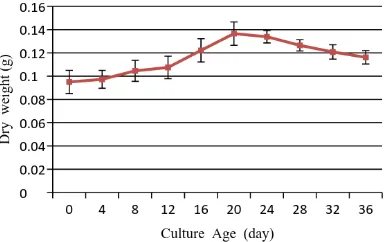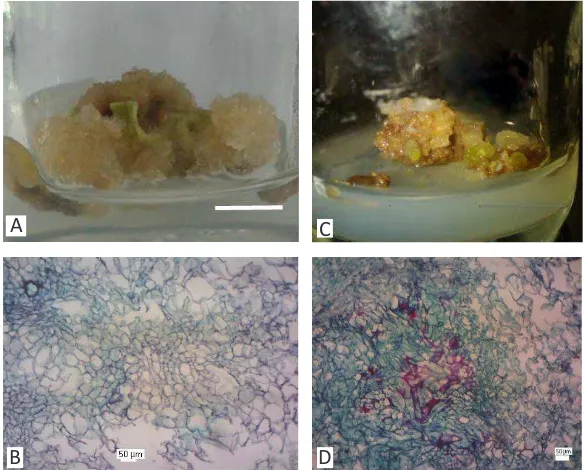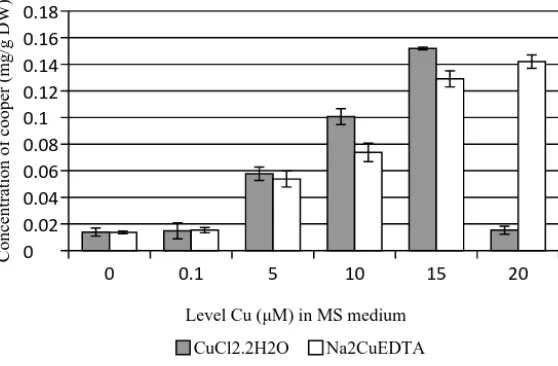Biosaintifika
Journal of Biology & Biology Educationhttp://journal.unnes.ac.id/nju/index.php/biosaintifika
Growth Pattern and Copper Accumulation in Callus of
Datura metel
Yulita Nurchayati1,5, Santosa2, Laurentius Hartanto Nugroho3, Ari Indrianto4
DOI: 10.15294/biosaintifika.v8i2.5177
1Postgraduate Program, Faculty of Biology, Universitas Gadjah Mada, Indonesia 2Plant Physiology Laboratory, Faculty of Biology, Universitas Gadjah Mada, Indonesia
3Plant Structure and Development Laboratory, Faculty of Biology, Universitas Gadjah Mada, Indonesia 4Biotechnology Laboratory, Faculty of Biology, Universitas Gadjah Mada, Indonesia
5Plant Structure and Function Laboratory, Faculty of Science and Mathematic, Universitas Diponegoro, Indo-nesia
Abstract
This experiment was aimed to evaluate the copper accumulation using callus culture of Datura metel L. The culture was established from leaves onto MS contained NAA 2.5 mg/L and Kinetin 0.5 mg/L as the control. The exposure of the culture was car-ried out by 2 copper compounds as treatment, i.e. CuCl2.2H2O and Na2CuEDTA at level concentration 0.; 0.1; 5; 10; 15; and 20 μM. The growth pattern of callus in control showed increasing growth rate in 36 days, whereas exponential stage was reached at 12-20th doi*. Whilst, after 10 doi, the treatment showed constant growth pattern. The absorption rate of the culture was increased by the addition of the CuCl2.2H2O at 5-15 μM of level concentration but declined at 20μM. The maxi-mum rate of accumulation of Cu (0,1519 mg g-1) was obtained at 15 μM. Instead, the addition of Na2CuEDTA at 5-20μM of level concentration showed the signifi-cant increment while the maximum accumulation was obtained at 20μM (0,1420 mg g-1). The existence of chelator in copper compound reduced the rate of toxicity while all tolerance index values were between 66,24 and 97,28 %.The results sug-gested the role of callus of D. metel as that fairly absorbed and accumulated Cu2+. Exposure with CuCl2.2H2O indicated higher accumulation than Na2CuEDTA.
How to Cite
Nurchayati, Y., Santosa, S., Nugroho, L. H., & Indrianto, A. (2016). Growth Pat-tern and Copper Accumulation in Callus of Datura metel. Biosaintifika: Journal of Biology & Biology Education, 8(2), 135-140.
© 2016 Semarang State University
History Article
Received 25 February 2016 Approved 15 June 2016 Published 18 September 2016
Keywords:
Datura metel L. callus culture; Copper; Bioaccu-mulation; Phytoremediation
Correspondence Author:
Bulaksumur, Yogyakarta 55281 E-mail: [email protected]
2009), include to heavy metal tolerance. In this study, the callus formed by in vitro culture was in-dicated the capability of absorbing Cu2+ from the
medium.
METHODS
Plant Material
The seeds of D. metel as plant material were collected from Central Java Indonesia in 2012 and were identified as the specimen in Departement of Biology, Faculty of Natural Science and Mat-hematics, Universitas Diponegoro, Semarang, In-donesia. The seeds were germinated in pot after soaking with tap water for 3 days. The seedlings were merged after 2 weeks of germination in the greenhouse, and it showed a good growth after 2 months, with 6 – 8 leaves. The third leaves from the apical shoot were used as an explant. The sur-face of leaves was sterilized in 30% of sodium hy-pochlorite for 5 min and then 70% ethanol for 30 sec. The explants were then washed with sterile distilled water for three times.
Callus Induction and Growth Pattern
The sterile leaves were cut into the small size and were cultured on the Murashige & Skoog (MS) as the basal medium with the addition of 3% (w/v) sucrose and it was solidified with 0.2% (w/v) gellan gum. This basal medium also was added to 2.5 mg/L NAA and 0.5 mg/L Kinetin as initiation medium. The pH was adjusted to 5.8, and then it was sterilized with the autoclave (121°C, at 1.5 atm for 15 min). Callus cultures were incubated in a growth chamber at 25 °C temperature and 16 h photoperiod of tube lamp. The cultures were subcultured by transferring cal-lus into fresh medium each 12 days. At the end of the third subculture (after 36 days), the callus were harvested as biomass and then was measu-red to obtain the growth curve.
One gram of callus from 36-days-old was transferred into fresh MS medium supplemented by NAA 2.5 mg/L and Kinetin 0.5 mg/L . Then, the callus was harvested each 4 days until 36 days. The fresh callus was cleaned from agar re-sidue by filter paper, then were dried by the oven at 60°C. This dry weight of callus represented the biomass.
Callus Treatment
The step of callus bioassay was initiated by transferring callus into MS medium supple-mented by the hormones with the different bination of concentration levels and copper
com-INTRODUCTION
Heavy metals (HMs) are natural compo-nents that in many ecosystems the concentration has reached toxic level due to anthropogenic acti-vities (Kanoun-Boule et al., 2008; Sharma, 2011). Several plants species have been investigated for their capability to reduce HMs toxicity. Member of Brassicaceae (Quartacci et al., 2003, Sharma & Dietz, 2006), Zea mays, (Ali et al., 2002), and aquatic plant i.e. water hyacinth (Eichhornia cras-sipes) or duckweed (Lemna minor L.) showed their role as phytoremediator towards Zn and Pb (Pras-sad & Freitas, 2003). A microalga Chlamydomonas
sp. was reported as soil and water remediator that contaminated by Arsenic (As) with accumulation rate more than 2 g As kg-1 DW. Datura metel is a herb that widely distributed in the tropical region, with many roles in pharmaceutical field as the antibacterial agent and potential to be exploited as the local anaesthetic (Bruce, 1999; Facchini, 2001. This plant has not been reported yet as a to-lerant species for copper or another HMs. Copper is one of heavy metal and has a significant role in the plant for the normal growth and develop-ment (Hall, 2002; Yruela, 2005). The copper is an important component of soil micronutrient for growth enhancement. This metal ion is also the essential factor for metalloprotein function (Pras-sad, 2004). Cu2+ is also required as the cofactor of
the enzymes involved in secondary metabolism (Yruela, 2005. Instead of many roles of copper for plants, the high concentration of this essen-tial metal can be harmful to growth and shows toxicity symptoms (Marschner, 1995; Hall, 2002; Prassad, 2004).
ob-5, 10, 1ob-5, and 20 μM). The pH of the medium was adjusted to 5,8.
Sample Harvesting
Ten-days-old calluses in all treatment were harvested separately. The fresh calluses were clea-ned from agar residue by filter paper, then were dried by the oven at 60 °C and subsequently be stored for further analysis.
Determination of Cu Content
Dried-callus of D. metel were digested using 4:1 of HNO3/HCl at 150 °C until the di-gest solution became clear in color. The didi-gested residue was filled up with distilled water up to 10 mL. The solution samples were analyzed for Cu content by atomic absorbance spectroscopy (AAS-Annalitik Jenna USA).
Tolerance Index
Dried-biomass measurement was used to determine tolerance index (TI) following the for-mula:
The ratio between a measured variable in treated plants and measured variable in control plants expressed as a percentage, as Equation(1), considering biomass dry weight, already defined:
TI = Biomass with Cu x 100% Biomass without HMs
Statistical Analysis
The experiments were carried out in five replication. The mean values with standard devi-ation (SD) were shown in the table and figures in the next section. The results were derived from statistical analysis using analysis of variance (ANOVA). Levels of significance were indicated by Duncan multiple range test at P<0.05. The coefficients of correlation were expressed using r-values.
RESULTS AND DISCUSSION
Callus Growth in MS Medium
The observation of growth pattern was carried out for 36 days. The callus was harvested each 4 days until the growth pattern showed the deceleration stage. The growth of the callus in-creased significantly with the exponential stage were gained between 12th-20th days of incubation.
Furthermore, the growth was declined and was reached the stationary stage (Fig. 1).
Figure 1. Growth curve of D. metel callus in MS
basal medium supplemented with 2,5 mg/L NAA and 0.5 mg/L Kinetin. Data showed means ± deviation standard of five replication of mea-surements
Leaves are commonly more convenient to be induced into callus in vitro by application of growth regulator than another plant organ. Leaves cutting were more easily to be callus in
Andrographis paniculata (Habibah, 2009), and in
Hibiscus sabdariffa than the petiols or calyx (Novia-ti, et al., 2014). This phenomenon was caused by the thick structure of leaves and less complexity of anatomical structure compared to either stem or root. This dedifferentiation of Datura leaves occurred on MS basal medium added by NAA 2.5 mg/L and Kinetin 0.5 mg/L. All parts of the explant enlarged and wrinkled in 7 days after ini-tiation. Primary callus was emerged from each side of cuttings, followed by the middle part of explant after 10 days of incubation. Callus prolif-eration occurred after the callus was subcultured into fresh medium. Some endogenous factor encouraged callus formation. Datura leaves are herbaceous in structure, arranged with parenchy-matous mesophyll and trichomes-rich on adaxial surface. Besides, the bicolateral vascular bundle of the stele of Datura was rich of cambium to stimulate cells division. Many plant tissue culture were showed the positive response to callus in-duction by 2,4 dichloro phenoxy acetic acid (2,4 D) as auxin source i.e. callus of Tridax procumbens
Copper Accumulation in Callus
Accumulation of copper ion was ob-served in D. metel callus, on both different kinds of copper compounds. The callus showed capa-bility in absorbing copper ion and the ion then be stored in their vacuoles. Based on Fig. 3, the callus showed the high activity of Cu2+
absorp-tion at 15 μM of level concentraabsorp-tion, followed by lowering its activity at 20 μM significantly. The cells allowed this Cu2+ to pass across the plasma
membrane and occupy its capacity without any leakage. Further, the highest concentration Cu2+
caused membrane disorder and the cells were lost its capability to accumulate the ion. This level in-dicated the critical point of callus to accumulate the ion.
The different result was observed in treat-ment by second Cu species, an organic copper. Absorption of Na2CuEDTA into cells of callus showed the increasing pattern (Fig 3.). The callus showed the increasing activity even in the highest level of Cu. In 20 μM of Na2CuEDTA concentra-tion, yet the Cu absorption was observed 0,1266 mg g-1 higher than the control equal to 822,08%.
It was suggested that copper was absorbed in che-lating form (CuEDTA). Copper was bound by EDTA and then would neutralize the charge of the molecule. By chelating form, this copper may pass through into cells. This evidence became the main reason that the application of highest level of copper will also correlate to the increas-ing of copper accumulation. Several
research-Table 1. Biomass (g) and tolerance index (%) of callus after 10-days treatment by different type of
copper compound and different level of concentration
Treatment Biomass (mg) Tolerance Index (%)
Cu (μM) CuCl2.2H2O Na2CuEDTA CuCl2.2H2O Na2CuEDTA
0.0 1.252cd 1.252cd 87.70 84.30
0.1 1.424a 1.485a 100.00 100.00
5.0 1.338b 1.218d 94.00 97.28
10.0 1.283c 1.162de 86.70 75.08
15.0 1.232d 1.088e 86.38 73.00
20.0 1.078e 0.999f 75.70 66.26
Note: Means followed by the same letter are not significantly different at a probability as determined by Duncan’s Multiple Range Test (P=0.03)
Figure 2. Callus of D. metel in (A-B) MS+NAA+Kinand in (C-D) MS+NAA+Kin+Cu10μM bar
(A,C) = 1 cm
A C
ers reported that chelation reduced heavy met-als toxicity (Hall, 2002; Prassad, 2004; Sharma & Dietz, 2006). Examination of chelation form was applied to a metallophyte Thlaspi caerulescens
with ZnEDTA compared with ZnSO4. This hy-peraccumulator plant tolerated and accumulated ZnSO4 under stress condition. Application of ZnEDTA decreased Zn uptake on both agar or liquid medium (Gerstmann et al., 2010).
The capability of Datura callus as Cu2+
bioaccumulator suggested that the cells con-tained phytochelatin, such protein analog with metallothionein. This protein was composed by glutamate and cysteine, that bound HMs ion and store them in vacuoles. Therefore, it reduces HMs toxicity as natural mechanisms occurred in the cell (Cobbett, 2000). This phytochelatin was also detected in Rauwolfia serpentina cell culture, which acts as marker towards Zn2+ and Cu2+
tox-icity (Grill, et al., 1997). The culture showed Cu2+
absorption into cells (served in CuCl2.2H2O) until 15 μM of level concentration. The biomass tend-ed to decrease in correlation with the increment of the copper level. Moreover, this callus had no capability to uptake this ion at 20 μM and this in-dicated the toxicity level. It suggested that this ion may cause growth inhibition. Hyperaccumulator plants will show the satisfied growth pattern even though they were exposed under stress condition (Sharma, 2011). According to Prassad (2004), tolerant plants species can adapt to the high level of Cu by changing the ion form to non-ionic pro-tein complexes. Probably, metabolic changes may occur to permit enzymes to act normally in a high concentration of metal, e.g. cell wall-bound phos-phatase in the roots area. Moreover, the high level of Cu2+ was toxic for the non-accumulator plant,
include D. metel, so that the biomass showed the lower mass than control (Yruela, 2005). The cel-lular copper toxicity was affecting the binding of sulfhydryl protein and inhibits enzyme function (Marschner, 1995). In this case, callus culture of Datura had no copper translocation mechanism into other parts, because of uniform-tissue-sys-tem. Nevertheless, the callus had the capability to uptake and accumulate them into their cells.
Based on Fig. 2C-D, callus section at CuCl2.2H2O 10 μM or 100-fold from normal level (0,1 μM) showed the thickness of cell wall. Sec-ondary cell wall composed of lignin has become the early response to recognizing the contami-nated–environment. This parts indicated first re-sponse or defense stage to toxic materials existed surrounding the cell.
CONCLUSION
The results concluded that the callus cul-ture of D. metel showed excellent growth in MS supplemented by NAA and Kinetin. This culture system showed the capability to absorb and ac-cumulate both species of copper. All treatments were significantly increased the Cu accumulation compared with the control, except for the 20μM of CuCl2 treatments. Examination of Cu2+
spe-cies (CuCl2.2H2O form) showed more convenient to be absorbed than chelating form though it showed inhibition of callus growth. The results indicated the concentration-dependent charac-teristics (r = 0.951) for the second compound of copper.
In further studies, this callus culture sys-tem would be regenerated into plantlets syssys-tem and subsequently be used as a model to explore
Figure 3. Accumulation of Cu2+ in D. metel callus by two different types of copper compound in MS
mental Botany, 53(366), 1-11.
Kanoun-Boulé, M., De Albuquerque, M. B., Nabais, C., & Freitas, H. (2008). Copper as an environ-mental contaminant: phytotoxicity and human health implications. Trace Elements as Contami-nants and Nutrients: Consequences in Ecosystems and Human Health, 653-678.
Marschner, H. (1995). Mineral Nutrition of Higher Plants, second edition. London: Academic Press. Nurchayati, Y. & Rahmah, F. A. (2010). Ascorbic acid
Content on Hibiscus sabdariffa L. Callus at vari-ous Concentration of Sucrose in MS media.
Majalah Obat Tradisional, 15(2), 71-74.
Noviati, A., Nurchayati, Y., & Setiari, N. (2015). Re-spon Pertumbuhan dan Produksi Senyawa Antioksidan pada Kalus Hibiscus sabdariffa L. dari Eksplan yang Berbeda secara in vitro. Jur-nal Sains dan Matematika, 22(1), 25-29.
Pilon-Smits, E. (2005). Phytoremediation. Annual Re-view of Plant Biology, 56, 15-39.
Prasad, M. N. V., & Freitas, H. D. O. (2003). Metal hyperaccumulation in plants—biodiversity prospecting forphytoremediation technology.
Electronic Journal of Biotechnology, 6(3), 110-146. Quartacci, M. F., Cosi, E., Meneguzzo, S., Sgherri, C.,
& Navari-Izzo, F. (2003). Uptake and transloca-tion of copper in Brassicaceae. Journal of Plant Nutrition, 26(5), 1065-1083.
Rahayu, S. E., & Sudarso. (2009). Qualitative Variants of Peanut Plants Obtained from in-Vitro Cul-ture and in-Vitro Selection. Biosaintifika: Journal of Biology & Biology Education, 1(1), 33-40. Sharma, H. (2011). Metal hyperaccumulation in
plants: a review focusing on phytoremediation technology. Journal of Environmental Science and Technology, 4(2), 118-138.
Sharma, S. S., & Dietz, K. J. (2006). The significance of amino acids and amino acid-derived mol-ecules in plant responses and adaptation to heavy metal stress. Journal of Experimental Bota-ny, 57(4), 711-726.
Sheldon, A. R., & Menzies, N. W. (2005). The ef-fect of copper toxicity on the growth and root morphology of Rhodes grass (Chloris gayana Knuth.) in resin buffered solution culture. Plant and Soil, 278(1-2), 341-349.
Wani, M., Pande, S., & More, N. (2010). Callus induc-tion studies in Tridax procumbens L. Interna-tional Journal of Biotechnology Applications, 2(1), 11-14.
Xu, X. Y., Shi, G. X., Wang, J., & Kang, Y. N. (2011). Copper-induced oxidative stress in Alternan-thera philoxeroides callus. Plant Cell, Tissue and Organ Culture (PCTOC), 106(2), 243-251. Yruela, I. (2005). Copper in plants. Brazilian Journal of
Plant Physiology, 17(1), 145-156.
the mechanism for tolerance and accumulation of copper. Moreover, this in vitro-generated callus can be exploited for secondary metabolites obser-vation.
ACKNOWLEDGEMENT
The author would like to thank the Direc-torate General of Higher Education of the Re-public Indonesia for its BPPDN Scholarship of the doctoral programme for 2011-2014.
REFERENCES
Ali, N. A., Bernal, M. P., & Ater, M. (2002). Tolerance and bioaccumulation of copper in Phragmites australis and Zea mays. Plant and Soil, 239(1), 103-111.
Antonio, A. B., Álvarez, L., Buendía-González, L., Maldonado-Magaña, A., & Cruz-Sosa, F. (2015). Accumulation and tolerance of Cr and Pb using a cell suspension culture system of Jatropha curcas. Plant Cell, Tissue and Organ Cul-ture (PCTOC), 120(1), 221-228.
Bruce, N. C. (1999). Alkaloid. Cambridge,UK. www. wiley-vch.de/books/pdf/v08a_alk.pdf
Cobbett, C. S. (2000). Phytochelatins and their roles in heavy metal detoxification. Plant Physiology, 123(3), 825-832.
Darsini, N. N. (2011). The Development of Laticifer on Callus Culture Catharanthus Roseus (L) G Don which were Induced by Plant Growth Regulator Combination Kinetin+ NAA. Jour-nal Biology, 15, 34-38.
Facchini, P. J. (2001). Alkaloid biosynthesis in plants: biochemistry, cell biology, molecular regula-tion, and metabolic engineering applications.
Annual Review of Plant Biology, 52(1), 29-66. Gerstmann, S., Adlassnig, W., Puschenreiter, M.,
Steinhauser, G., & Lichtscheid, I. (2010). In vi-tro Culture of Metallophyte Thlaspi caerulescens : culture media and Application of Toxic Heavy Metals. Poster in Universitat Wien.
Grill, E., Winnacker, E. L., & Zenk, M. H. (1987). Phytochelatins, a class of heavy-metal-binding peptides from plants, are functionally analo-gous to metallothioneins. Proceedings of the Na-tional Academy of Sciences, 84(2), 439-443. Habibah, N. (2009). Effectiveness of Jasmonic Acid
Elicitor Addition for Andrographolide Synthe-sis Induction of Sambiloto Culture. Biosainti-fika: Journal of Biology & Biology Education, 1(1), 11-18.


